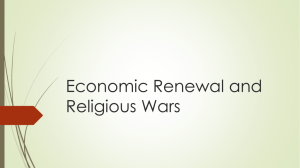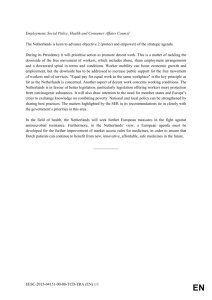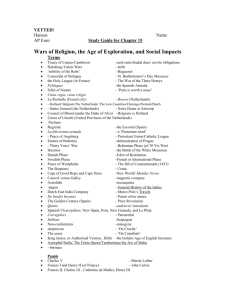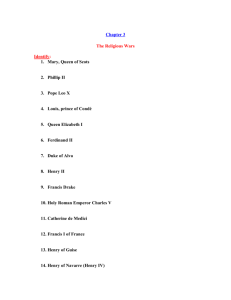Chapter 15B Politics, Religion, and War
advertisement
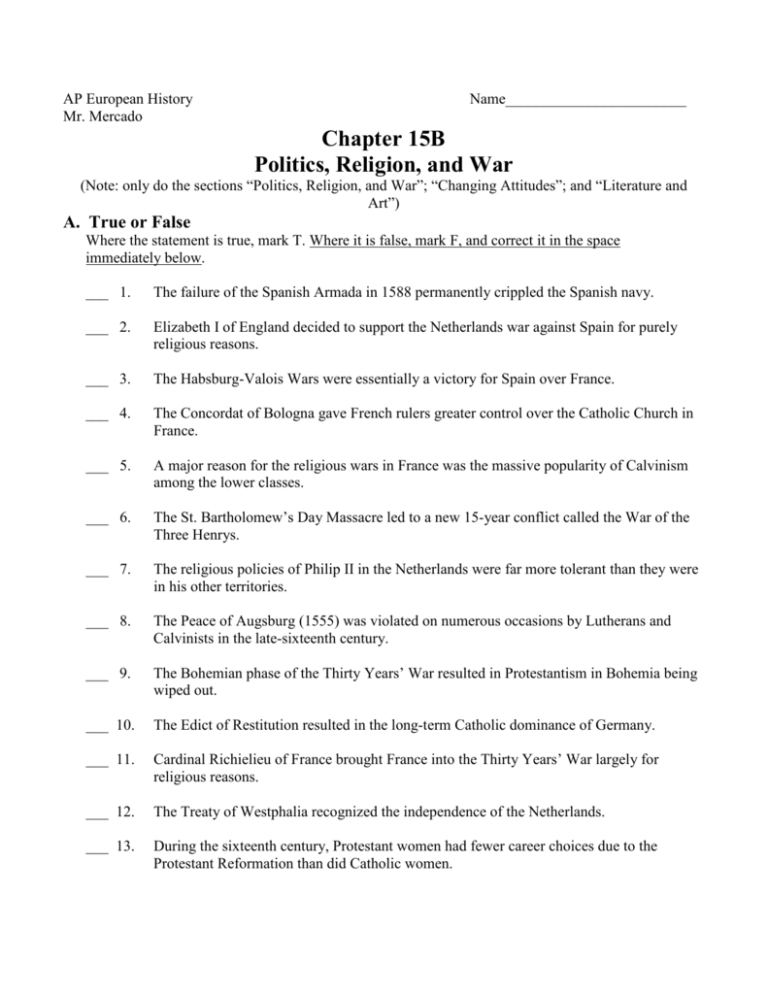
AP European History Mr. Mercado Name________________________ Chapter 15B Politics, Religion, and War (Note: only do the sections “Politics, Religion, and War”; “Changing Attitudes”; and “Literature and Art”) A. True or False Where the statement is true, mark T. Where it is false, mark F, and correct it in the space immediately below. ___ 1. The failure of the Spanish Armada in 1588 permanently crippled the Spanish navy. ___ 2. Elizabeth I of England decided to support the Netherlands war against Spain for purely religious reasons. ___ 3. The Habsburg-Valois Wars were essentially a victory for Spain over France. ___ 4. The Concordat of Bologna gave French rulers greater control over the Catholic Church in France. ___ 5. A major reason for the religious wars in France was the massive popularity of Calvinism among the lower classes. ___ 6. The St. Bartholomew’s Day Massacre led to a new 15-year conflict called the War of the Three Henrys. ___ 7. The religious policies of Philip II in the Netherlands were far more tolerant than they were in his other territories. ___ 8. The Peace of Augsburg (1555) was violated on numerous occasions by Lutherans and Calvinists in the late-sixteenth century. ___ 9. The Bohemian phase of the Thirty Years’ War resulted in Protestantism in Bohemia being wiped out. ___ 10. The Edict of Restitution resulted in the long-term Catholic dominance of Germany. ___ 11. Cardinal Richielieu of France brought France into the Thirty Years’ War largely for religious reasons. ___ 12. The Treaty of Westphalia recognized the independence of the Netherlands. ___ 13. During the sixteenth century, Protestant women had fewer career choices due to the Protestant Reformation than did Catholic women. McKay Ch. 15B Homework Packet Page 2 ___ 14. The religious wars of the sixteenth and early seventeenth centuries resulted in the rise of women being persecuted for witchcraft. ___ 15. The baroque style grew independently of the influence of the Catholic Church. B. Multiple Choice Select the best answer and write the proper letter in the space provided. ___ 1. Beginning in 1581, the northern Netherlands revolted against their political overlord, which was a. France. b. Spain c. Elizabeth I of England d. Florence ___ 2. In the Thirty Years’ War, France supported a. German Catholics b. the Holy Roman Emperor c. Spain d. German Protestants ___ 3. All of the following statements about the Spanish Armada of 1588 are true EXCEPT a. It was the beginning of a long war with England. b. It failed in its objective. c. It prevented Philip II from reimposing unity on western Europe by force. d. It made possible Spanish conquest of the Netherlands. ___ 4. The nation that considered itself the international defender of Catholicism was a. France b. Spain c. Italy d. England ___ 5. By which treaty did the king of France, Francis I, recognize the supremacy of the papacy? a. The Treaty of Westphalia b. The treaty of Cateau-Cambrésis c. The Concordat of Bologna d. The Edict of Nantes ___ 6. France was saved from religious anarchy when religious principles were set aside for political necessity by King a. Henry III b. Francis I c. Henry IV of Navarre d. Charles IX ___ 7. Calvinism was appealing to the middle classes for each of the following reasons EXCEPT a. its heavy moral emphasis. b. its stress on leisure and ostentatious living. c. its intellectual emphasis. d. its approval of any job well done, hard work, and success. ___ 8. The vast palace of the Spanish monarchs, built under the direction of Philip II, was called a. Versailles. b. the Escorial. c. Tournai. d. Hampton Court. McKay Ch. 15B Homework Packet Page 3 ___ 9. The Treaty of Westphalia, which ended the Thirty Years’ War a. further strengthened the Holy Roman Empire. b. completely undermined the Holy Roman Empire as a viable state. c. maintained that only Catholicism and Lutheranism were legitimate religions. d. refused to recognize the independence of the United Provinces of the Netherlands. ___ 10. The ten southern provinces of the Netherlands, known as the Spanish Netherlands, became the future a. Netherlands b. Bohemia c. Belgium d. Denmark ___ 11. The Thirty Years’ War was fought primarily a. on German soil. b. in France c. in eastern Europe d. in Spain ___ 12. The Treaty of Cateau-Cambrésis ended the a. Hapsburg-Valois Wars b. existence of the Papal States c. Peasants’ Revolt d. Thirty Years’ War ___ 13. Many Calvinists were murdered in Paris in 1572 in the massacre of a. the Edict of Nantes b. the 30 Years’ War c. the Hapsburgs d. St. Bartholomew’s Day ___ 14. The catalyst or immediate cause for the Thirty Years’ War was the a. Defenstration of Prague b. St. Bartholomew’s Day Massacre c. The Spanish Armada d. The abdication of Charles V ___ 15. Women during the 16th century a. were expected, ideally, to be unrealistically thin. b. were urged in popular literature to accept their husbands’ extramarital liaisons quietly. c. were barred from participation in their husbands’ businesses. d. were accused of being witches far more frequently than men. C. Identification Supply the correct identification for each numbered description. ___________ 1. The war that brought destruction and political fragmentation to Germany. ___________ 2. The law of 1598 that granted religious freedom to French Protestants. __________ 3. The king of Sweden who intervened in the Thirty Years’ War. McKay Ch. 15B Homework Packet Page 4 __________ 4. After 1581, the name for the seven northern provinces of the Netherlands. _________ 5. The monarch of England at the time of the Spanish Armada. _________ 6. The emperor who divided the Habsburg empire into two parts. _________ 7. The religious compromise between church and state in France. __________ 8. The term used to identify French Calvinists. __________ 9. __________ 10. The English king under which the new Authorized Bible was published. The French king and politique who supposedly said, “Paris is worth a mass,” in order to gain the loyalty of Catholics. D. Matching People, Places, and Events Match the person, place, or event in the left column with the proper description in the right column by inserting the correct letter on the blank line. ___ 1. Gustavus Adolphus ___ 2. William of Orange ___ 3. Albert of Wallenstein ___ 4. Mary, Queen of Scots ___ 5. Francis I ___ 6. Catherine de’ Medici ___ 7. Mary Tudor ___ 8. Peace of Augsburg ___ 9. Treaty of Cateau-Cambrésis ___ 10. Treaty of Westphalia A. Mercenary general who was hired by the Holy Roman Empire to destroy Protestantism in Germany. B. Treaty that ended the dynastic wars between the French Valois and the Hapsburgs. C. Legal heir to the English throne who was executed on the orders of Elizabeth I D. Swedish king whose participation in the 30 Years’ War may have saved the Protestant cause.. E. Agreement that sought to end religious conflict in the Holy Roman Empire in the 16th century but ultimately failed thus leading to the Thirty Years’ War. F. French king who gained control over appointments to the church in France and fought a series of wars against the Habsburgs. G. Treaty that gave German rulers the right to choose between Catholicism, Lutheranism and Calvinism in their realms. H. Protestant leader of the Netherlands who led the fight against Philip II. I. Wife of Philip II who sought to restore Catholicism in England. J. French regent who dominated her son’s reign and played a major role in the French Civil Wars. McKay Ch. 15B Homework Packet Page 5 E. Geography 1. On Outline Map 15.2 provided, and using Map 15.2 in the textbook as a reference, mark the following: (7 points) • areas under Spanish Habsburg control • areas under Austrian Habsburg control • the United Netherlands • the German states • the boundary of the old Holy Roman Empire • Swedish possessions Outline Map 15.2
